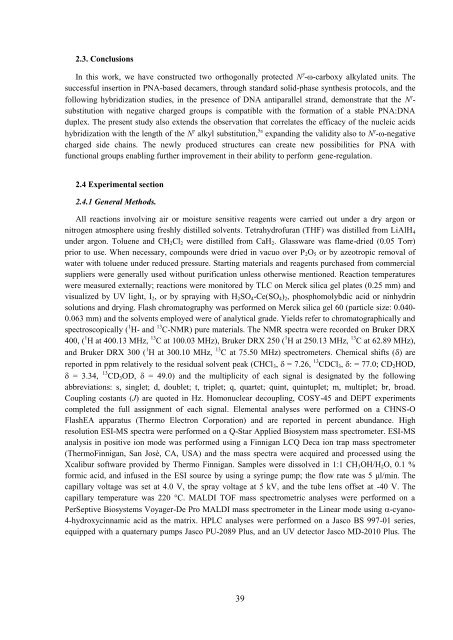Synthesis and characterization of linear and cyclic ... - EleA@UniSA
Synthesis and characterization of linear and cyclic ... - EleA@UniSA
Synthesis and characterization of linear and cyclic ... - EleA@UniSA
You also want an ePaper? Increase the reach of your titles
YUMPU automatically turns print PDFs into web optimized ePapers that Google loves.
2.3. Conclusions<br />
In this work, we have constructed two orthogonally protected N --carboxy alkylated units. The<br />
successful insertion in PNA-based decamers, through st<strong>and</strong>ard solid-phase synthesis protocols, <strong>and</strong> the<br />
following hybridization studies, in the presence <strong>of</strong> DNA antiparallel str<strong>and</strong>, demonstrate that the N -<br />
substitution with negative charged groups is compatible with the formation <strong>of</strong> a stable PNA:DNA<br />
duplex. The present study also extends the observation that correlates the efficacy <strong>of</strong> the nucleic acids<br />
hybridization with the length <strong>of</strong> the N alkyl substitution, 5a exp<strong>and</strong>ing the validity also to N --negative<br />
charged side chains. The newly produced structures can create new possibilities for PNA with<br />
functional groups enabling further improvement in their ability to perform gene-regulation.<br />
2.4 Experimental section<br />
2.4.1 General Methods.<br />
All reactions involving air or moisture sensitive reagents were carried out under a dry argon or<br />
nitrogen atmosphere using freshly distilled solvents. Tetrahydr<strong>of</strong>uran (THF) was distilled from LiAlH4<br />
under argon. Toluene <strong>and</strong> CH2Cl2 were distilled from CaH2. Glassware was flame-dried (0.05 Torr)<br />
prior to use. When necessary, compounds were dried in vacuo over P2O5 or by azeotropic removal <strong>of</strong><br />
water with toluene under reduced pressure. Starting materials <strong>and</strong> reagents purchased from commercial<br />
suppliers were generally used without purification unless otherwise mentioned. Reaction temperatures<br />
were measured externally; reactions were monitored by TLC on Merck silica gel plates (0.25 mm) <strong>and</strong><br />
visualized by UV light, I2, or by spraying with H2SO4-Ce(SO4)2, phosphomolybdic acid or ninhydrin<br />
solutions <strong>and</strong> drying. Flash chromatography was performed on Merck silica gel 60 (particle size: 0.040-<br />
0.063 mm) <strong>and</strong> the solvents employed were <strong>of</strong> analytical grade. Yields refer to chromatographically <strong>and</strong><br />
spectroscopically ( 1 H- <strong>and</strong> 13 C-NMR) pure materials. The NMR spectra were recorded on Bruker DRX<br />
400, ( 1 H at 400.13 MHz, 13 C at 100.03 MHz), Bruker DRX 250 ( 1 H at 250.13 MHz, 13 C at 62.89 MHz),<br />
<strong>and</strong> Bruker DRX 300 ( 1 H at 300.10 MHz, 13 C at 75.50 MHz) spectrometers. Chemical shifts () are<br />
reported in ppm relatively to the residual solvent peak (CHCl3, = 7.26, 13 CDCl3, : = 77.0; CD2HOD,<br />
= 3.34, 13 CD3OD, = 49.0) <strong>and</strong> the multiplicity <strong>of</strong> each signal is designated by the following<br />
abbreviations: s, singlet; d, doublet; t, triplet; q, quartet; quint, quintuplet; m, multiplet; br, broad.<br />
Coupling costants (J) are quoted in Hz. Homonuclear decoupling, COSY-45 <strong>and</strong> DEPT experiments<br />
completed the full assignment <strong>of</strong> each signal. Elemental analyses were performed on a CHNS-O<br />
FlashEA apparatus (Thermo Electron Corporation) <strong>and</strong> are reported in percent abundance. High<br />
resolution ESI-MS spectra were performed on a Q-Star Applied Biosystem mass spectrometer. ESI-MS<br />
analysis in positive ion mode was performed using a Finnigan LCQ Deca ion trap mass spectrometer<br />
(ThermoFinnigan, San Josè, CA, USA) <strong>and</strong> the mass spectra were acquired <strong>and</strong> processed using the<br />
Xcalibur s<strong>of</strong>tware provided by Thermo Finnigan. Samples were dissolved in 1:1 CH3OH/H2O, 0.1 %<br />
formic acid, <strong>and</strong> infused in the ESI source by using a syringe pump; the flow rate was 5 μl/min. The<br />
capillary voltage was set at 4.0 V, the spray voltage at 5 kV, <strong>and</strong> the tube lens <strong>of</strong>fset at -40 V. The<br />
capillary temperature was 220 °C. MALDI TOF mass spectrometric analyses were performed on a<br />
PerSeptive Biosystems Voyager-De Pro MALDI mass spectrometer in the Linear mode using -cyano-<br />
4-hydroxycinnamic acid as the matrix. HPLC analyses were performed on a Jasco BS 997-01 series,<br />
equipped with a quaternary pumps Jasco PU-2089 Plus, <strong>and</strong> an UV detector Jasco MD-2010 Plus. The<br />
39

















